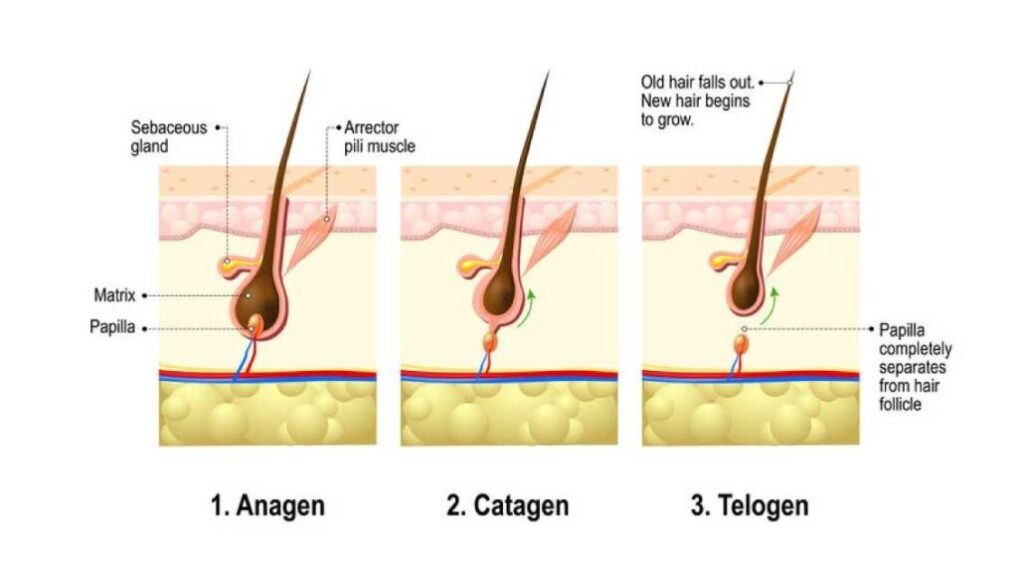Performance-enhancing drugs (PEDs), particularly anabolic steroids, have become a popular choice for athletes and fitness enthusiasts aiming to boost performance or physique. However, one troubling side effect associated with their use is hair loss, which can significantly impact self-esteem and overall quality of life.
This relationship between PEDs and hair loss stems from the drugs’ hormonal effects, particularly their influence on testosterone and its derivatives.
Understanding the Connection Between PEDs and Hair Loss
Hair loss from PEDs often results from their androgenic effects, particularly the elevation of dihydrotestosterone (DHT). DHT is a potent derivative of testosterone produced through the action of the enzyme 5-alpha reductase.
While DHT plays essential roles in the body, excessive levels can bind to androgen receptors in hair follicles, particularly on the scalp, leading to follicular miniaturization—a hallmark of androgenetic alopecia (male or female pattern baldness).
The hair growth cycle consists of three phases:
- Anagen (growth phase)
- Catagen (transitional phase)
- Telogen (resting phase)

Through their effect on DHT levels, performance-enhancing drugs can shorten the anagen phase and prolong the telogen phase, leading to thinner, weaker hair strands and eventual shedding. Additionally, androgenic compounds may impair scalp health, increasing inflammation and reducing blood flow to hair follicles.
Factors Influencing Hair Loss
Genetic Predisposition and Hormonal Imbalance
Individuals with a genetic predisposition to hair loss are more likely to experience accelerated balding when using PEDs. Hormonal imbalances caused by PED use, including spikes in testosterone and estrogen levels, can further exacerbate hair thinning. Those with a family history of alopecia should be particularly cautious when considering PED use.
Environmental and Lifestyle Factors
Excessive sebum production, triggered by PED-induced hormonal changes, can clog hair follicles and lead to scalp inflammation, worsening hair loss. Stress—common among high-performance athletes—also significantly increases cortisol levels, negatively impacting hair growth.
Combining these factors with poor lifestyle choices, such as inadequate sleep or an unhealthy diet, can further compromise hair health.
Treatment Options for Managing Hair Loss
Several medical interventions can help manage hair loss related to PEDs:
- Minoxidil (Rogaine): A topical solution that stimulates hair follicles and prolongs the anagen phase.
- Finasteride (Propecia): An oral medication that inhibits 5-alpha reductase, reducing DHT levels.
- Laser Therapy: Low-level laser devices can improve blood flow to the scalp, promoting regrowth.
Supporting hair health through proper nutrition is crucial:
- Biotin and Zinc: Essential for keratin production and hair strength.
- Saw Palmetto: A natural DHT blocker that can complement medical treatments.
- Vitamin D and Omega-3 Fatty Acids: Promote overall scalp health and hair growth.

A balanced diet rich in vitamins and minerals is vital for long-term improvement.
Preventive Measures and Lifestyle Modifications
Reducing DHT levels is a critical step in preventing further hair loss. This can include using scalp massage techniques to improve blood flow and opting for shampoos containing ketoconazole or caffeine, which target DHT buildup. Maintaining a nutrient-rich diet and avoiding harsh hair products can also support scalp health.
For those seeking immediate results or long-term solutions:
- Hair Transplant Surgery: Transplanting hair from resistant areas can restore a natural look.
- Scalp Micropigmentation: A non-invasive technique to simulate the appearance of hair on the scalp.
- Thickening Products: Temporary sprays and powders can enhance hair volume and conceal thinning areas.
Seeking Professional Guidance
A dermatologist can provide a personalized treatment plan based on an individual’s hair loss pattern and history. Dermatological assessments may include scalp biopsies or blood tests to identify underlying issues, ensuring a targeted approach to management.
Successful hair loss treatment often requires consistent monitoring and adjustments. Regular follow-ups with healthcare providers ensure that therapies remain effective and promptly address any side effects. Open communication with specialists can help refine strategies and set realistic expectations for recovery.
Frequently Asked Questions
How do performance-enhancing drugs cause hair loss?
PEDs increase dihydrotestosterone (DHT) levels, a testosterone derivative that shrinks hair follicles and disrupts the hair growth cycle, leading to thinning and shedding.
Can stopping performance-enhancing drugs reverse hair loss?
Discontinuing PEDs can reduce further hair loss, but regrowth may depend on the extent of follicular damage and individual factors. Medical treatments like minoxidil may help stimulate regrowth.
Are there natural alternatives to prevent hair loss while using performance-enhancing drugs?
Natural DHT blockers like saw palmetto and a healthy diet rich in vitamins and minerals can support hair health. However, they may not fully prevent hair loss in genetically predisposed individuals.



